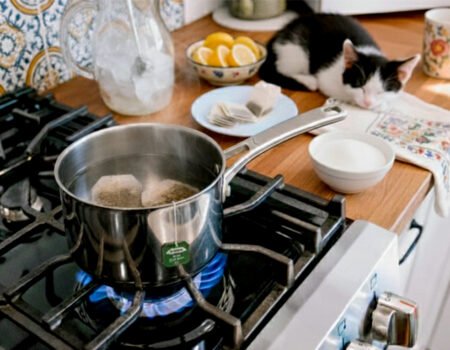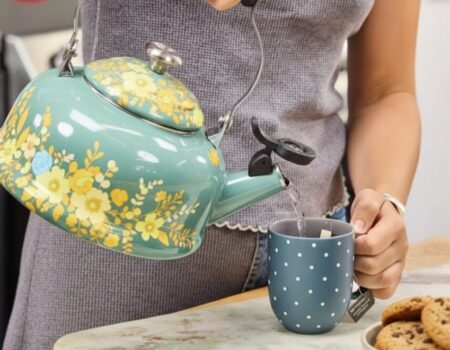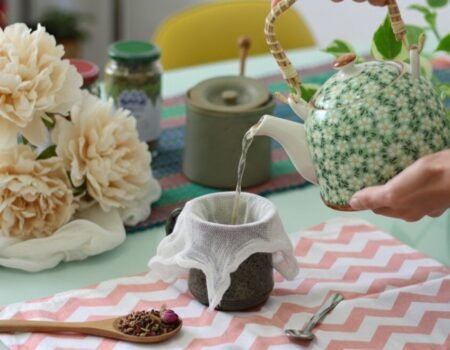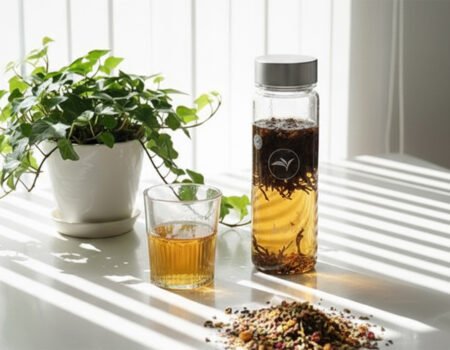
A Guide to Properly Making Tea
Index
The right brewing method can transform your daily cup from ordinary to amazing.
This guide will show you how to select the best tea, heat water to the perfect temperature, and steep for just the right amount of time. Your perfect cup awaits.
Key Takeaways
- Water temperature matters greatly when brewing tea – black tea needs boiling water (212°F), while green tea requires cooler water (175-180°F).
- Steep time varies by tea type: black tea needs 3-5 minutes, green tea 2 minutes, white tea 1-2 minutes, and oolong 2-3 minutes.
- Quality loose leaf tea delivers better flavor than tea bags because the leaves have more room to expand fully.
- Fresh, filtered water brings out the true taste of tea compared to tap water with chlorine.
- The brewing process dates back over 4,000 years to China, with Lu Yu’s tea manual from 792 CE documenting proper methods still used today.
Preparing to Brew the Perfect Cup of Tea

Gather your tools and ingredients
Gathering the right tools makes brewing tea a breeze. You’ll need just a few basic items to start your tea journey.
- Tea leaves are the heart of your brew, so select quality loose leaf tea for the best flavor. Loose tea offers better taste than tea bags and lets you control the strength.
- A reliable kettle heats water to the exact temperature needed for different tea types. Electric kettles with temperature settings work great for precise brewing.
- Measuring tools help you use the right amount of tea per cup. One teaspoon of loose tea per 8 ounces of water works as a standard starting point.
- An infuser or strainer holds tea leaves while they steep in hot water. Basket strainers give tea leaves more room to expand than tea balls, creating better flavor.
- A teapot provides space for tea leaves to unfurl fully during brewing. Ceramic or glass pots maintain heat well during the steeping process.
- Fresh, filtered water brings out the true taste of your tea. Spring water often yields the best results compared to tap water with chlorine.
- A timer ensures you steep your tea for the perfect amount of time. Different teas need different steeping times for optimal flavor.
- A mug or cup serves as your final vessel for enjoying the finished brew. Preheating it with hot water helps maintain your tea’s temperature.
Choose the right type of tea

Tea selection matters greatly for your perfect cup. Black tea offers bold flavor and high caffeine, making it ideal for morning energy boosts. Green tea provides a lighter taste with less caffeine, perfect for afternoon sipping.
Oolong sits between these two with medium caffeine and complex flavors. Match your tea type to your mood and schedule – avoid caffeinated options like black or green teas in the evening if you’re sensitive to stimulants.
Herbal teas and rooibos contain zero caffeine, making them excellent nighttime choices.
The quality of your tea leaves directly impacts your brewing results. Loose leaf tea typically delivers better flavor than bagged varieties because the leaves have room to expand fully.
Many tea drinkers notice that whole tea leaves release more complex flavors compared to the dust often found in tea bags. For beginners, try sampling different tea types before buying in bulk.
Your water quality also affects the final taste, so filtered water often creates a cleaner-tasting cup of tea.
What Does it Mean to Brew Tea?

Brewing tea involves extracting flavors and compounds from tea leaves using hot water. This ancient practice dates back over 4,000 years to China, where people first discovered the delightful results of steeping leaves in heated water.
The process pulls out the natural oils, caffeine, and flavor elements that give each tea its unique taste profile. Lu Yu’s famous tea manual from 792 CE, called “Cha Jing”, first documented proper brewing methods that still guide tea lovers today.
The art of tea brewing focuses on four main factors: water quality, temperature, steeping time, and leaf-to-water ratio. Each type of tea leaf needs specific conditions to release its best flavors.
For example, delicate green teas require cooler water than robust black teas. The brewing method you choose affects how the final cup tastes, whether you use a teapot, infuser, or French press.
Making these small adjustments can transform an ordinary cup into the best tasting tea experience.
Essential Techniques for Brewing Tea
Brewing tea requires specific techniques for the best flavor and aroma. Master these essential methods to transform ordinary tea into an exceptional experience.
Heat water to the ideal temperature

Tea needs specific temperatures to release its best flavors. Black tea thrives at 212°F (boiling point), while green and white teas require gentler heat between 175°F and 180°F.
You’ll get better results using an electric kettle with a temperature sensor for perfect accuracy. Most tea mistakes happen when water is too hot, which burns delicate leaves and creates bitter tea.
Pu-erh and herbal tisanes need the full 212°F boil to extract their full character.
Different tea leaves demand different heat levels for optimal taste. The main rule is simple: darker teas like black varieties need hotter water, while lighter teas like green need cooler temperatures.
Many tea lovers use a digital thermometer to check water heat before pouring it over leaves. This step might seem small, but it makes a huge difference in your final cup. The right temperature brings out sweet notes instead of harsh ones.
Steep for the recommended time

After heating your water to the right temperature, timing your steep becomes the next crucial step. Different teas need specific steeping times to release their best flavors. Black tea requires 3-5 minutes in hot water to develop its rich taste.
Green tea needs a shorter bath of about 2 minutes to avoid bitterness. White tea steeps quickly at just 1-2 minutes, while oolong falls in the middle range at 2-3 minutes.
Your teapot or cup serves as the vessel for this transformation. The tea leaves unfurl and release their flavors during this waiting period. You can adjust these times based on your taste preferences.
A shorter steep creates a milder cup, while extra minutes produce a stronger brew. Many tea drinkers use a kitchen timer to track steeping time precisely. This simple step makes a big difference between a perfect cup and a disappointing one.
Customizing Your Tea

Tea offers endless ways to match your personal taste preferences. You can adjust brewing time for strength, add sweeteners like honey or sugar, or enhance flavor with lemon, milk, or spices.
Adjust strength, sweetness, or additions to taste
Customizing Your Tea
Making tea to your exact taste creates a more enjoyable experience. You can adjust several elements to craft your perfect cup.
- Control tea strength by changing brew time. Steep for less time if you prefer milder flavor or longer for a stronger cup.
- Add sweeteners like honey, sugar, or natural alternatives to balance any astringency. Start with small amounts and taste as you go.
- Try a splash of milk to soften bold black teas like English Breakfast. Milk works best with stronger brews that can stand up to its creamy texture.
- Explore lemon slices for a bright, citrusy note in your hot tea. This addition pairs especially well with black or green varieties.
- Consider brewing temperature adjustments for a less bitter cup. Using slightly cooler water can reduce astringency while maintaining flavor.
- Test different steeping vessels such as a teapot or infuser mug. Each affects how the water circulates around the leaves.
- Experiment with the amount of loose leaf tea used. One teaspoon per cup works as a starting point, but you might prefer more or less.
- Taste your tea plain first, especially with high-quality loose leaf varieties. This helps you appreciate the full flavor profile before adding anything.
- Mix in herbs or spices like mint, cinnamon, or ginger for custom flavors. These additions can transform even simple teas into special drinks.
- Create multiple infusions from the same leaves to experience how the flavor changes. Many oolong teas taste different with each steep.
Conclusion

Brewing tea combines science and art to create your perfect cup. The right water, proper steep time, and ideal temperature form the base of great tea. You can adjust these elements to match your taste, making each cup truly yours.
Tea offers a moment of calm in busy days, so take time to enjoy the process. With these tips, you’ll brew better tea and gain more joy from this timeless drink.
FAQs
1. What is the best way to make tea?
The best way to make tea starts with fresh, cold water heated to the right temperature for your tea type. Pour hot water over the leaves and let them steep for the proper time. Using loose leaf tea rather than bags will give you better flavor and a richer cup.
2. How much tea should I use per cup?
Add one teaspoon of tea per cup for regular strength. For a stronger brew, add an extra teaspoon to the pot first. Cold brew tea requires two teaspoons per cup since the extraction process is slower.
3. What water temperature is best for different types of tea?
Green and white teas need water around 175°F, while black and herbal infusions require a full boil at 212°F. Pu’er tea and oolong fall in between at about 190°F. The right temperature prevents bitterness while extracting proper flavor.
4. Should I add milk to my tea?
This depends entirely on how you like your tea. Black teas are often best served with milk, while green and white teas taste better without. Never add milk to herbal infusions as it can curdle and affect the flavor.
5. How long should I steep tea?
Steeping time varies by tea type. Black tea needs 3-5 minutes, green tea 2-3 minutes, and herbal infusions 5-7 minutes. The main parameters affecting tea taste are steeping time and water temperature.
6. What’s the difference between making hot tea and cold brew tea?
Hot tea involves pouring hot water over leaves and steeping for minutes. Cold brew tea requires steeping leaves in cold water for 8-12 hours in the refrigerator. Cold brewing creates a smoother taste with less caffeine content and no bitterness.
References
- https://artfultea.com/blogs/101/how-to-prepare-tea?srsltid=AfmBOoqwZeABr233gJxVBhbOTc-ZhTab81x5659Q4yWkCQNC3S2Ewjs9
- https://artfultea.com/blogs/101/how-to-prepare-tea?srsltid=AfmBOooERLjKz9QRSYa-srXFUwzb8St3s1O0YTviFs_Eq8xLmBjtDeGY
- https://www.artoftea.com/blogs/tea-101/a-guide-to-preparing-the-best-cup-of-tea
- https://www.popularmechanics.com/science/a38389312/how-to-brew-tea/
- https://twiningsusa.com/pages/how-to-brew-the-perfect-cup-of-tea?srsltid=AfmBOoro-MbliRQKFLInCh6EEHHF4kri6_pesGyTqVcsceI_LOEcEawF
- https://artfultea.com/blogs/101/tea-brewing-temperature-guide?srsltid=AfmBOor2Dgc0VTOwHsUAywX7m1twBTFYyL7kz_PlCM2fcPGEQxrtkwEE
- https://twiningsusa.com/pages/how-to-brew-the-perfect-cup-of-tea?srsltid=AfmBOooT5OMnZH37NJq_60Bqvhw4ogi0aMacZNgXqbB6CZsbaA3CdA1P
- https://twiningsusa.com/pages/how-to-brew-the-perfect-cup-of-tea?srsltid=AfmBOopLnr_uJ9p1oGaXXaTBx-UIP-kgQWdxLJgRWAl41GUbCZAcMHEV
- https://www.consumerreports.org/food/how-to-make-the-perfect-cup-of-tea-a3628637729/
- https://twiningsusa.com/pages/how-to-brew-the-perfect-cup-of-tea?srsltid=AfmBOopwbhbMG-MS0Cd3Y17Gtkv6AAfwCsscVcG2NBRfOTpJlIvwe7Ns






